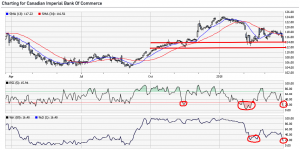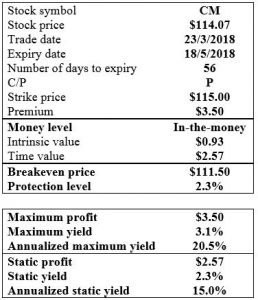Writing put options on a support level

As the following graph shows, the share price of Canadian Imperial Bank of Commerce (CM) has been trending downward since the beginning of 2018. When markets closed on Friday, March 23, CM was trading at $114.07. But as we can see, a price range of $112 to $114 has represented a support level from which prices surged twice. Furthermore, when the RSI (Relative Strength Index) and stochastic oscillator are at oversold levels, as they are now, it is not unusual to see prices rally more or less strongly.
Daily chart as at March 23, 2018 ($114.07)

Under such conditions, an investor who is still bullish about the market’s prospects in the medium term can profit from this weakness in the price of CM, writing puts to benefit should the stock stage a rebound or remain relatively stable. But if prices continue to fall, the investor should then be ready to buy the shares at the selected strike.
Position
- Sale of 10 put options CM 180518 P 115 at $3.50
- Credit of $3,500
Profit and loss profile

By writing ten puts, CM 180518 P 115 at $3.50, we collect $3,500 ($3.50 x 10 contracts x 100 shares per contract). As the above table shows, this put option is currently $0.93/share in-the-money (strike of $115 – current price of $114.07) and contains $2.57 in time value ($3.50 – $0.93). This $3.50 premium per share provides us with protection against a drop of as much as 2.3%, i.e. to the breakeven price of $111.50 (strike of $115 – premium of $3.50), which is just under of the $112 support level. The strategy’s maximum profit is the total credit collected, or $3,500, and will be realized if CM closes at a price that is higher than or equal to the $115 strike on expiration of the options on May 18, 2018. This profit represents a 3.1% yield over 56 days, or an annualized yield of 20.5%. The static profit, i.e. the profit generated if the stock price remains unchanged, is $2.57 per share, for a total amount of $2,570 on the 10 contracts. The static yield is equal to 2.3% over 56 days, for an annualized static yield of 15%. At expiration, if the price of CM is still below the $115 strike, the investor will be obliged to buy 1,000 shares of CM at $115 per share, for a cost of $111.50 per share (strike of $115 – premium of $3.50). Any decline below this level will represent a loss on the strategy.
Intervention
There are three ways to manage this position. The first is for the investor who is not afraid to buy the shares if the price falls. In this case, the position is held without intervening, and if the stock falls below the $115 strike on expiration, the shares are assigned and the investor simply buys them back. The second approach is to intervene if the price falls significantly below the breakeven price, by buying the put options written as a way of cutting the losses. The third approach involves intervening if the price of the shares rises significantly, by buying the put options written for 10% to 20% of their initial premium (in this case, for between $0.35 and $0.70). In the last two cases, other put options can be written, if this is still justified.
Good luck with your trading, and have a good week!
The strategies presented in this blog are for information and training purposes only, and should not be interpreted as recommendations to buy or sell any security. As always, you should ensure that you are comfortable with the proposed scenarios and ready to assume all the risks before implementing an option strategy.
President
Monetis Financial Corporation
Martin Noël earned an MBA in Financial Services from UQÀM in 2003. That same year, he was awarded the Fellow of the Institute of Canadian Bankers and a Silver Medal for his remarkable efforts in the Professional Banking Program. Martin began his career in the derivatives field in 1983 as an options market maker for options, on the floor at the Montréal Exchange and for various brokerage firms. He later worked as an options specialist and then went on to become an independent trader. In 1996, Mr. Noël joined the Montréal Exchange as the options market manager, a role that saw him contributing to the development of the Canadian options market. In 2001, he helped found the Montréal Exchange’s Derivatives Institute, where he acted as an educational advisor. Since 2005, Martin has been an instructor at UQÀM, teaching a graduate course on derivatives. Since May 2009, he has dedicated himself full-time to his position as the president of CORPORATION FINANCIÈRE MONÉTIS, a professional trading and financial communications firm. Martin regularly assists with issues related to options at the Montréal Exchange.
The information provided on this website, including financial and economic data, quotes and any analysis or interpretation thereof, is provided solely for information purposes and shall not be construed in any jurisdiction as providing any advice or recommendation with respect to the purchase or sale of any derivative instrument, underlying security or any other financial instrument or as providing legal, accounting, tax, financial or investment advice. Bourse de Montréal Inc. recommends that you consult your own advisors in accordance with your needs before making decision to take into account your particular investment objectives, financial situation and individual needs.
All references on this website to specifications, rules and obligations concerning a product are subject to the rules, policies and procedures of Bourse de Montréal Inc. and its clearinghouse, the Canadian Derivatives Clearing Corporation, which prevail over the content of this website. Although care has been taken in the preparation of the documents published on this website, Bourse de Montréal Inc. and/or its affiliates do not guarantee the accuracy or completeness of the information published on this website and reserve the right to amend or review, at any time and without prior notice, the content of these documents. Neither Bourse de Montréal Inc. nor any of its affiliates, directors, officers, employees or agents shall be liable for any damages, losses or costs incurred as a result of any errors or omissions on this website or of the use of or reliance upon any information appearing on this website.
BAX®, CADC®, CGB®, CGF®, CGZ®, LGB®, MX®, OBX®, OGB®, OIS-MX®, ONX®, SCF®, SXA®, SXB®, SXF®, SXH®, SXM®, SXO®, SXY®, and USX® are registered trademarks of the Bourse. OBW™, OBY™, OBZ™, SXK™, SXJ™, SXU™, SXV™, Montréal Exchange and the Montréal Exchange logo are trademarks of the Bourse. All other trademarks used are the property of their respective owners.
© 2024 Bourse de Montréal Inc. All Rights Reserved.
